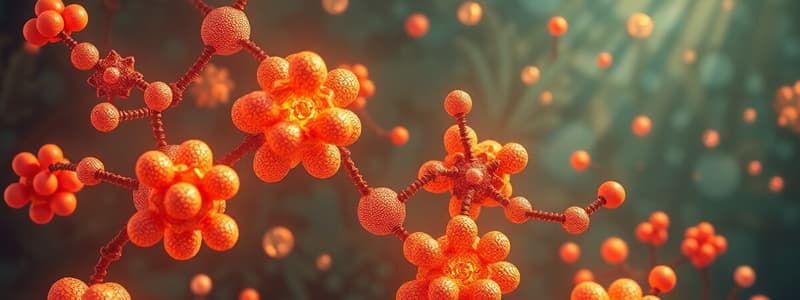Podcast
Questions and Answers
What is the primary function of carbohydrates in biological systems?
What is the primary function of carbohydrates in biological systems?
- Structural support
- Energy storage (correct)
- Cellular recognition
- All of the above
Which type of lipid is a major component of cell membranes?
Which type of lipid is a major component of cell membranes?
- Triglycerides
- Fatty acids
- Steroids
- Phospholipids (correct)
What process describes the formation of polymers from monomers?
What process describes the formation of polymers from monomers?
- Hydrolysis
- Dehydration synthesis (correct)
- Fermentation
- Replication
Which of the following best describes the secondary structure of proteins?
Which of the following best describes the secondary structure of proteins?
What is the primary function of nucleic acids in living organisms?
What is the primary function of nucleic acids in living organisms?
Which type of macromolecule functions as enzymes in biological systems?
Which type of macromolecule functions as enzymes in biological systems?
What occurs during hydrolysis of a polymer?
What occurs during hydrolysis of a polymer?
Which type of carbohydrate is formed from two monosaccharides?
Which type of carbohydrate is formed from two monosaccharides?
Flashcards are hidden until you start studying
Study Notes
Overview of Macromolecules
- Macromolecules are large, complex molecules essential for life.
- They are typically composed of long chains of smaller units called monomers.
Types of Macromolecules
-
Carbohydrates
- Composed of carbon, hydrogen, and oxygen (C, H, O).
- Function: Energy storage, structural support, and cellular recognition.
- Types:
- Monosaccharides: Simple sugars (e.g., glucose, fructose).
- Disaccharides: Two monosaccharides (e.g., sucrose, lactose).
- Polysaccharides: Long chains (e.g., starch, glycogen, cellulose).
-
Lipids
- Diverse group, primarily hydrophobic.
- Function: Energy storage, membrane structure, signaling.
- Types:
- Fatty Acids: Saturated (no double bonds) and unsaturated (one or more double bonds).
- Triglycerides: Composed of glycerol and three fatty acids.
- Phospholipids: Major component of cell membranes.
- Steroids: Structured like cholesterol; involved in signaling.
-
Proteins
- Composed of amino acids linked by peptide bonds.
- Function: Catalysis (enzymes), structural support, transport, signaling.
- Levels of structure:
- Primary: Sequence of amino acids.
- Secondary: Alpha helices and beta sheets (hydrogen bonding).
- Tertiary: 3D folding due to interactions between side chains.
- Quaternary: Multiple polypeptide chains assembled together.
-
Nucleic Acids
- Composed of nucleotides (sugar, phosphate group, nitrogenous base).
- Function: Store and transmit genetic information.
- Types:
- DNA (Deoxyribonucleic Acid): Double-stranded, contains genetic blueprint.
- RNA (Ribonucleic Acid): Single-stranded, involved in protein synthesis and gene regulation.
Key Concepts
- Macromolecule Synthesis: Polymers are formed through dehydration synthesis (condensation reaction), where monomers lose water to bond together.
- Macromolecule Breakdown: Polymers are broken down into monomers through hydrolysis, which requires water.
- Enzymatic Activity: Specific enzymes catalyze the synthesis and breakdown of macromolecules, playing a crucial role in metabolism.
Macromolecules Overview
- Large, complex molecules essential for life
- Composed of long chains of smaller units called monomers
Carbohydrates
- Composed of carbon, hydrogen, and oxygen (C, H, O)
- Function: Energy storage, structural support, and cellular recognition
- Types: Monosaccharides, Disaccharides, Polysaccharides
Monosaccharides
- Simple sugars
- Examples: Glucose, Fructose
Disaccharides
- Two monosaccharides linked together
- Examples: Sucrose, Lactose
Polysaccharides
- Long chains of monosaccharides
- Examples: Starch, Glycogen, Cellulose
Lipids
- Diverse group of hydrophobic molecules
- Function: Energy storage, membrane structure, signaling
- Types: Fatty Acids, Triglycerides, Phospholipids, Steroids
Fatty Acids
- Saturated: No double bonds between carbon atoms
- Unsaturated: One or more double bonds between carbon atoms
Triglycerides
- Composed of glycerol and three fatty acids
Phospholipids
- Major component of cell membranes
- Have a hydrophilic head and hydrophobic tail
Steroids
- Structured like cholesterol
- Involved in signaling
Proteins
- Composed of amino acids linked by peptide bonds
- Function: Catalysis (enzymes), structural support, transport, signaling
Protein Structure
- Primary: Sequence of amino acids
- Secondary: Alpha helices and beta sheets formed by hydrogen bonding
- Tertiary: 3D folding due to interactions between side chains
- Quaternary: Multiple polypeptide chains assembled together
Nucleic Acids
- Composed of nucleotides (sugar, phosphate group, nitrogenous base)
- Function: Store and transmit genetic information
DNA (Deoxyribonucleic Acid)
- Double-stranded
- Contains the genetic blueprint
RNA (Ribonucleic Acid)
- Single-stranded
- Involved in protein synthesis and gene regulation
Macromolecule Synthesis & Breakdown
- Dehydration synthesis: Monomers bond together by losing water molecules
- Hydrolysis: Water is added to break the bond between monomers
Enzymatic Activity
- Specific enzymes catalyze the synthesis and breakdown of macromolecules
- Play a crucial role in metabolism
Studying That Suits You
Use AI to generate personalized quizzes and flashcards to suit your learning preferences.



